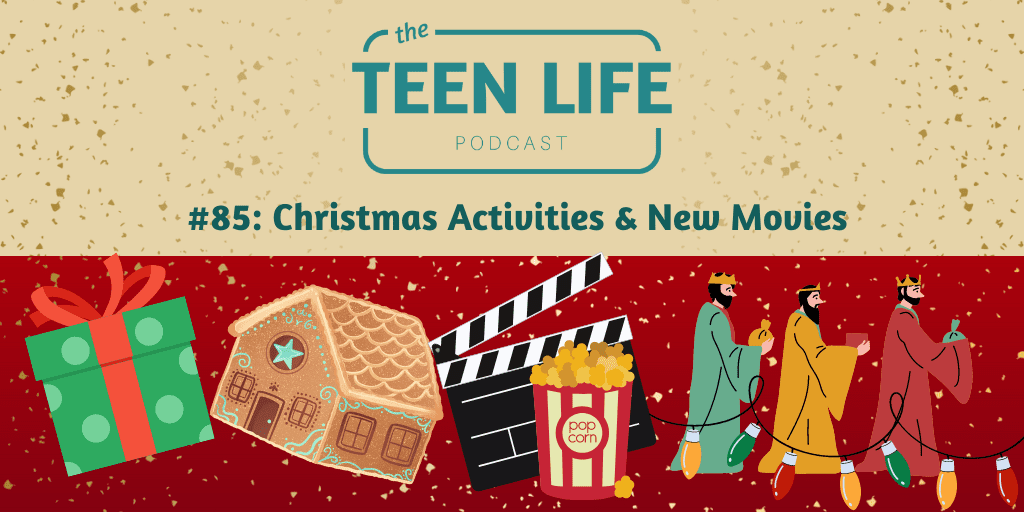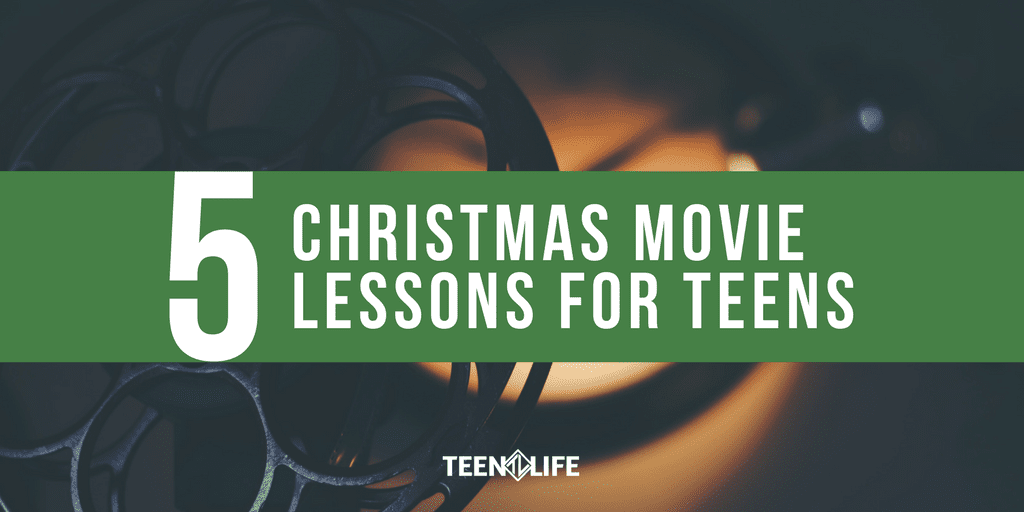
Ep. 85: Christmas Activities & New Movies
Podcast: Play in new window | Download
What Christmas traditions do you look forward to every year?
Chris and Karlie share a plethora of great ideas for holiday traditions that will involve the teenagers in your family and create great memories for everyone. We’ve also got a great lineup of movies to see this season in theaters or on streaming. Be sure to stay tuned for our tip on how to make the holidays more meaningful.
In this episode, we mentioned or used the following resources:
- Entertainment Weekly: Widows, meteorologists, and secret recipes: The biggest trends in new Christmas movies
- PureWow: The 77 Best Family Christmas Movies to Watch with Your Kids This Holiday Season
- Avatar: The Way of Water
- I Wanna Dance with Somebody
- Glass Onion: A Knives Out Mystery
- A Man Called Otto
- Lubbock Christian University: Youth Ministry Degree
- LCU Contact: David Fraze
- Podcast music by Luke Cabrera & Tobin Hodges
Have a question?
If you have a question about something you heard or just want to give us some feedback, please leave us a comment below. We would love to hear from you!
Read the Transcript
0:07
Welcome to the team live podcast, where we believe the teenagers are not a problem to be solved.
We are here to help you equip teenagers, ^ connection as welcome back during this holiday season.
And this is Chris Roby in over across.
From me, is Karlie Duke.
0:23
Hello, Chris.
It’s a wonderful time of year.
It is.
It’s my favorite time of year.
Yeah.
A lot going on.
On.
And if you haven’t noticed here on the podcast, we are in full Christmas mode and here to talk about it because the holidays are that unique time of the year and the way that we handle uses families and our relationship with teenagers and support and something, we can put some thought into for sure.
0:50
And so, today, we want to talk through Christmas activities, things we can do as a family things you can do with your student that will have a lot of meaning.
Yeah, I’ve Loved this time of year and it’s fascinating to me to hear how people do it differently.
1:09
And what people do and next week we have a super fun episode coming out where we’re actually going to bring in Tobin and Priscilla two of our co-workers to kind of talk about the differences of Christmas, so don’t miss that.
But today we want to talk about some Christmas activities and maybe your family already does some of these He’s or maybe you’ll get some new ideas for how to connect with your teens, this holiday season, because honestly, it’s crazy.
1:38
It really is going a million different ways and not actually find time to connect with the teenagers in your life.
So whether you’re a parent or a teacher or just someone who loves teenagers, hopefully this gives you some fun ideas of things to do together.
1:54
Yeah it kind of helps you go.
Get ahead of it a little bit because before we know it our students will be on the school and the older, your teenager gets the less, they’re going to be around the house, they’re going to be more of their friends are going to be.
They’re going to be with me.
2:09
They’re working any of those kinds of things.
And so being able to plan out some intentional time to connect this time of year is really important.
And so we have just a few ideas, we feel like can be, you can do with your teenager.
2:25
One of them is, we talked about this a little bit last week, but is to follow up, is to do a small gift exchange like a white elephant.
Something like that where you’re able to exchange a gift but nothing too big.
Just something small to have fun together as a family, right?
2:43
You could set a budget of $5 or $10 and kind of be like, hey, let’s do something small together.
I kind of mentioned this last week too, but maybe even do like an IOU.
Gift exchange, where everyone exchanges some sort of coupon.
2:59
Maybe it’s all do dishes for a month, or I’ll give you a back rub while we watch a movie, something like that, that doesn’t actually cost money, but could be fun everyone in your family can participate in, no matter what age they are, or it might be a little late because I know this episode is coming out, right before school gets out, but if you’re a teacher, you could also do this.
3:21
If like, hey everyone go to the dollar store and pick up something, three dollars or under and we’re going to do a fun gift exchange.
So that could be a fun way to connect with teenagers.
Another is finding a way to give back to others and I feel like we maybe briefly, mentioned this in the last episode, but I kind of wanted to talk about it a little more because there are lots of ways to serve others this time of year.
3:48
Well, into we talked about in this way back, but you know, what, cause do you support as a family or that your teenager cares about.
And so we, you know, we really focus on mental, the mental health supports that a teenager needs, right?
4:07
That’s what this big reason why we exist and so people are drawn to us who really care about that issue.
And most nonprofits have some kind of issue.
They’re looking to serve.
And so talk to your student about what do they really care about what really drives and motivates them and likely there is some charity or non-profit in your town, that’s trying to address that need and seeking to maybe volunteer with them.
4:34
Give some amount to them.
Raise that awareness for that issue that your teenager really really cares about, because they’re likely is someone trying to address that issue actively in your community?
Yeah they’re also this time of year lots of ways to like you said, volunteer your time huh?
4:53
I’m so whether that’s writing letters.
Hers or I don’t know.
We used to do our church used to do.
I think they might still do it but like almost like Santa workshops, where families could come and pick out presents for their kids and you could volunteer to help run that and help them pick out gifts and put together bikes or, I don’t know, just lots of different things.
5:18
Volunteer at a homeless shelter, take clothes or socks.
To a homeless shelter, put together food packages, and drive around town.
If you see someone on the side of the road, give him something.
There are lots of things that you could do to involve your teenagers.
5:34
And like you said, I think that’s such a great idea.
Chris to ask them, what do you want to do?
Instead of you just planning it but like, hey, what are you passionate about?
What do you think would be fun?
And a way that we could serve as a family, either as a class or as a youth group?
This Christmas here.
Absolutely.
5:49
But the you do together as a family which I think is a really great idea, because you can do it pretty cheap too is to bake a family recipe together or if you don’t really have like a family cookbook that’s passed down, just Googling a really fun recipe.
Something you can make together or ruin together.
6:07
Honestly, I think he’s it doesn’t always go the way that you want them.
Do you want to?
But that experience of cracking the eggs and mixing and all those kinds of things together.
Could be really fun tradition if you haven’t started one to do together.
Hmm.
6:23
Speaking of traditions, I think it could be fun to start a new tradition.
Uh-huh.
If your family doesn’t have a lot of traditions or you realize these are Traditions, we’ve just always done, but I’ve never invited our family into it and what they want to do and say like, hey let’s ask around.
6:38
Let’s research what are fun.
Christmas traditions and pick one and say this is our new family tradition, and it could be something small like looking at Christmas lights or drinking hot chocolate while you watch a Christmas movie.
It doesn’t have to be Something big, but just saying like, Hey, we’re going to sit down and maybe you have everyone submit a tradition and you draw or you take an anonymous vote, something like that.
7:03
To make it fun for your kids.
Well, I think too, that’s an opportunity.
If you’re starting a new tradition or even just engaging, the one that you’ve always had to encourage your student to invite a friend and say, Hey, you know, we’re trying this new thing, I’m tell us what you think, or what that looks.
7:22
Like this to be able to include someone, they especially someone who might not have a family who has Traditions or does things like that.
And so I think in a way that’s act of giving to include someone in something like that.
So you know expanding expanding your sense of what family is.
7:40
During that time could be really, really powerful.
Another way, maybe this could become a tradition is at some point, this holiday season have a family night where everyone picks a different piece.
So, maybe one person picks the movie, one picks a snack, one picks a game that you play.
7:58
It can be small things like that, but that way, everyone feels like they have a say in some part of the night and some ownership in what they do.
And they can plan that out.
And that could be a really fun way to be together while also getting the buy-in from your teen. And so they’ll want to do it because you are listening to this podcast, we can assume a couple of things, one that you have great taste and to that you care about teenagers.
8:57
Chris, I want to talk about some new movies coming out because this season is one of my favorites because I love movies.
It’s a little harder now that I have little kids to get out.
Go see a movie.
So I haven’t seen a lot lately, but there are a ton of new movies that come out this year.
9:14
Both in theaters on streaming services obviously channels like Hallmark and lifetime have 1 million Christmas movies that don’t cost anything for you to watch them from home.
And so I’m going to post a link in the show notes for a full list of the must-see Christmas movies for this year.
9:34
I’m also going to post a link of the 77 best family Christmas movies of all time.
So that’s like if you live in these seven.
Yeah.
Wow.
That’s what I found.
Are there a lot of Christmas movie.
So if you like Classics or maybe you look at that list and pick one that your kids have never seen, that is one that you loved watching when you were a teenager that Could be a fun way to jog your memory and watch something from home and most of these, I’m pretty sure these lists tell you where you can actually watch them too.
10:05
And so that could be a good idea.
But let’s actually talk about some movies coming out to theaters because there are a few Chris.
Yeah, some of these, I feel like I’ve seen advertised for very long time now.
Yes, are just now coming out?
10:21
Yes.
So Avatar, the way of water, which is the Avatar sequel.
I can’t even remember how long ago.
The original one came out but it’s been a long time.
It’s been 13 years.
Yeah.
Well, and so that comes out December 16th.
So that comes out this week and that’s one that obviously people are talking a lot about, maybe you watch the original Avatar.
10:43
First, I’m pretty sure The Originals on Disney plus it is if you want to watch that.
Yeah, this is the big one.
It’s a big one to see him 3D apparently, hmm.
Oh, that makes me so sick.
Oh yeah.
I really hope I won’t be one of those ones but yeah apparently that’s what they’re saying.
11:00
Yeah.
Now, if you are a Whitney Houston fan, I want to dance with.
Somebody is like the Whitney Houston movie that talks about her life.
It really does look really fascinating.
If you’re one of those that loves I feel like there’s a real Trend making these movies and I think these are the same people that did Bohemian Rhapsody, okay?
11:22
And that comes out December 21st.
So that could be one if you love music.
If you love singing, obviously they’re going to be a lot of songs in that one.
And so that could hit a different audience.
This next one, I’m excited, I’m excited about because I love the original movie mode called Glass Onion with Daniel Craig.
11:40
It’s a Knives Out mystery and so if you ever saw the original Knives Out with Daniel Craig, in this kind of big ensemble, cast a few years back, you were person of my age, who loved the original Clue movie.
It’s very in that vein of movies of just kind of who done it and they’re all kind of locked into a house until I can figure out, you know, the crime has Daniel Craig coming back as the original Inspector, but a new cast.
12:09
Yeah.
And a new mystery.
And so I’m I’m actually really excited about this one when this comes out on Netflix.
Yes. 23rd, right.
Yes.
So this one did when we’re recording this, I think it’s out in theaters right now but it’s out for a very short amount of time.
12:27
So by the time you listen to this episode, you might not be able to even see it in theaters anymore, but it will be on Netflix, December 23rd.
So that’s an easy.
One that you can watch from home as a family, not even have to go anywhere.
Now, the last one I want to talk about is a Man called Otto, which they’re doing a limited theatrical release on December 25th, but then they’re doing their full release in January.
12:54
And this is based on the best-selling book by Frederick Backman.
It’s starring Tom, Hanks, I didn’t read this book, but I think I have to add it to my list because so many people have talked about how much they loved this book and I’ve read some of his other stuff, but this could be a really interesting one to check out and you could check it out on Christmas or wait until January when it comes out everywhere.
13:21
Now finally Chris for the tip, I kind of just want to talk about this season as a whole because I was we said it is a busy one and it’s easy to get caught up in the activities in the stress and the financial implications of buying all these gifts and doing all the things.
13:41
But I want everyone to kind of do something to remind yourself, why we even do this time of year.
Now obviously, me and you come from a faith background and so ours is rooted in celebrating the birth of Christ and that might not be the reason everyone listening is celebrating, but have a moment where as a family you talk about, okay, why are we even doing this?
14:09
Why are we doing everything?
And is what the activities that were doing are those lining up with our reason?
As well.
So some things you could do is, you could read an advent book or do some sort of advent calendar to count down.
14:26
I have friends, I wish I did Advent better, but I have friends who light the candles.
And talk about the symbolic meanings behind each piece of Advent, and read different pieces of the Bible or a study together as a family.
14:42
And so that could be an option that you do at this time of year.
Maybe if you are in a faith community, go to a Christmas Eve service.
Those are much more available now than they were one of our even I was younger.
And so something you can do to go worship together or celebrate together as a family is really, really, really meaningful and I feel like now so many churches around us have more options and there are online services.
15:11
If you’re not ready to get out, they also have a lot of places do Christmas Eve services on the 23rd and the 24th.
So if you have certain Traditions that your family does on the 24th, you could find somewhere on the 23rd to go and still do that as a family and then be able to travel or do all the Christmas things that you usually do.
15:33
I think just to make sure that whatever we do, we make sure it’s not just about the gifts or the activities that, you know, the things that you value as a family are Amplified That you know, we it’s just it’s a we talked, we talked about being self-aware, a lot and you know, knowing what’s important to you as an individual, what’s important to you in your relationships.
16:01
And so that’s what a lot of this is about.
I believe around the holiday season no matter how you celebrate it, what you what you believe is how, you know, as a family.
What do we think support?
Make sure we urge that or within my Peer relationships, any of those kinds of things, I think, I think being able to show, you know, we just got done with Thanksgiving, but this, this whole season is about gratitude.
16:26
Yeah.
And finding ways that we can instill that value into a teenager that, you know, we’re grateful for our faith community.
We’re grateful for a family were grateful for our relationships and how we express those things.
This makes sure that as you head into this holiday season, especially with some I’m at a school that you, you amplify that also with this podcast to we’re looking forward to wrapping up our our ball.
16:57
I guess with a special episode next week where Carly and I will be joined by Tobin and Priscilla the kind of share some, it’ll be a lighter episode of just sharing stories and about different Traditions things that we thought was fun as a teenager and so be sure that you tune into that.
17:16
That next week.
But yeah.
Oh I was just going to go ahead and preview after that.
I think we’re going to do like three episodes where we’re going to take pieces of old episodes that are still really relevant.
That are some of our favorites that we said, hey, this was really good stuff and if you missed it, like if you join the team live podcast late, you might not have heard this.
17:39
And so we’re going to do that.
And also kind of intro, maybe if anything changed, but be looking for those episodes to going into the New Year.
So we’re not taking a break.
It’ll be a little different for a few weeks, but then we’ll come back in January.
It’s with that.
17:54
That’s a wrap on this podcast.
If you like this podcast, please, be sure to subscribe.
So this shows up in your feed every single week, follow us on social media.
We are on all the big social channels and say you can find this just by searching teen life.
And you’ll find us wherever you consume that material, write us on your favorite podcast, app share with a friend and make sure that the people around, you know, about this great content.
18:22
And if we don’t see, or then we hope you have a wonderful holiday and we will see you next time.
About Us:

Karlie Duke
Communications Director

Chris Robey
Former CEO
Chris Robey | Former CEO
Chris has spent most of his career empowering teenagers from all backgrounds. As the former leader of Teen Life, he is passionate about helping students make good choices while also giving adults the tools they need to communicate more effectively with teens. Chris is a graduate of Midwestern State University and holds a Master’s Degree in Family Life Education from Lubbock Christian University.
Karlie Duke | Director of Communications
Karlie has always had a heart for teenagers. Through her role at Teen Life, she loves to showcase the amazing stories coming out of Support Groups, but she is especially passionate about helping adults and teenagers find connection. Karlie has a BS in Communications with a minor in Family Studies from Abilene Christian University.

















